Strategic Information System Report for Commonwealth Bank of Australia
VerifiedAdded on 2020/03/28
|13
|2933
|158
Report
AI Summary
This business report offers a comprehensive analysis of the Commonwealth Bank of Australia (CBA), focusing on its strategic information system. The report delves into the organizational structure of CBA, its operational challenges, and the system acquisition methods employed, including cloud computing and ERP systems. It examines the sales processes, control issues, and risks associated with the bank's operations. Furthermore, the report explores the development and adoption of the Accounting Information System (AIS), market size, and the competitive advantages of market leaders within the Australian banking industry. It identifies current gaps and challenges faced by CBA, providing insights into the evolving technological landscape and its impact on the bank's market position and customer service. The report concludes with recommendations for addressing these challenges and ensuring CBA's continued success in a competitive market.
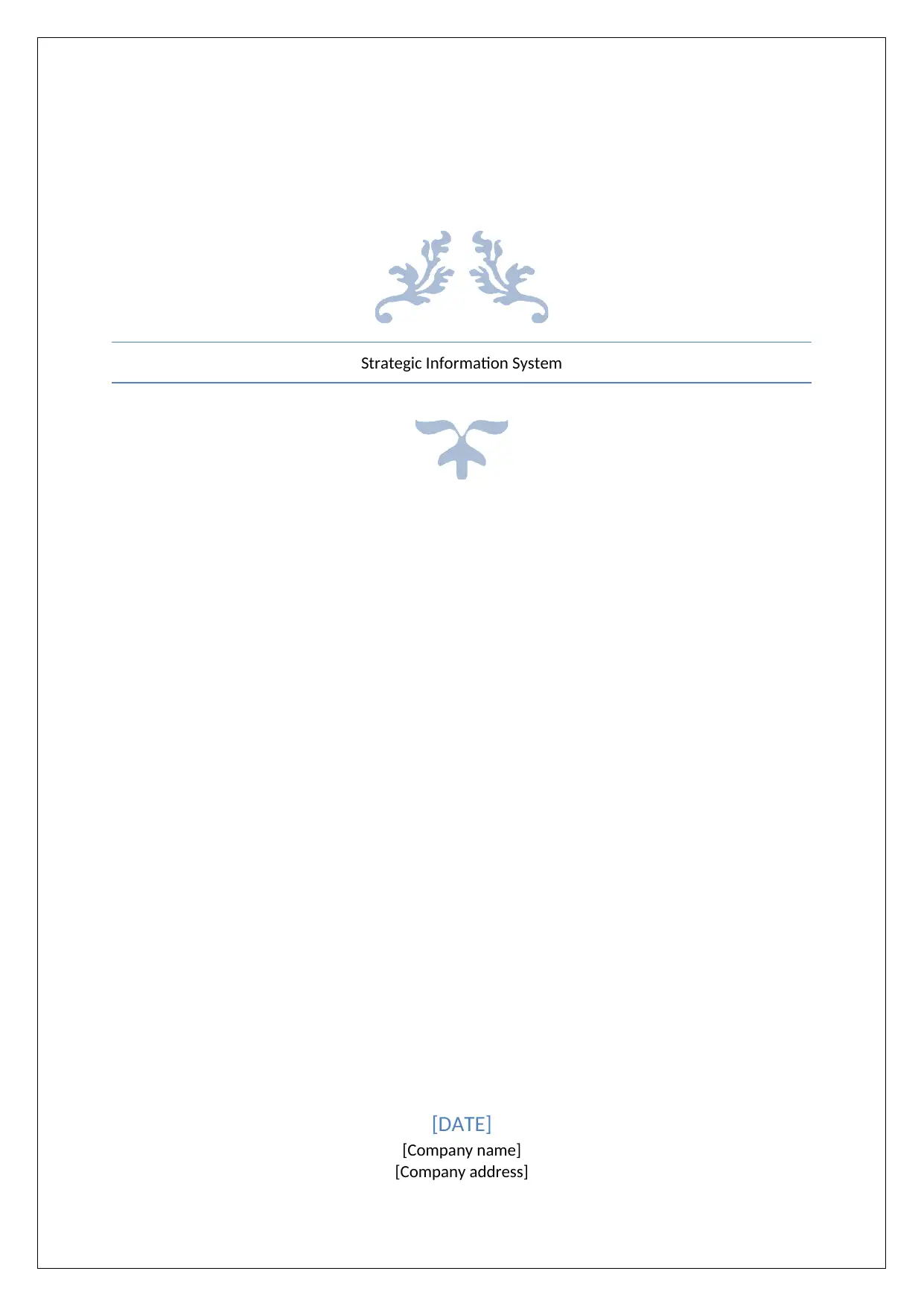
Strategic Information System
[DATE]
[Company name]
[Company address]
[DATE]
[Company name]
[Company address]
Paraphrase This Document
Need a fresh take? Get an instant paraphrase of this document with our AI Paraphraser
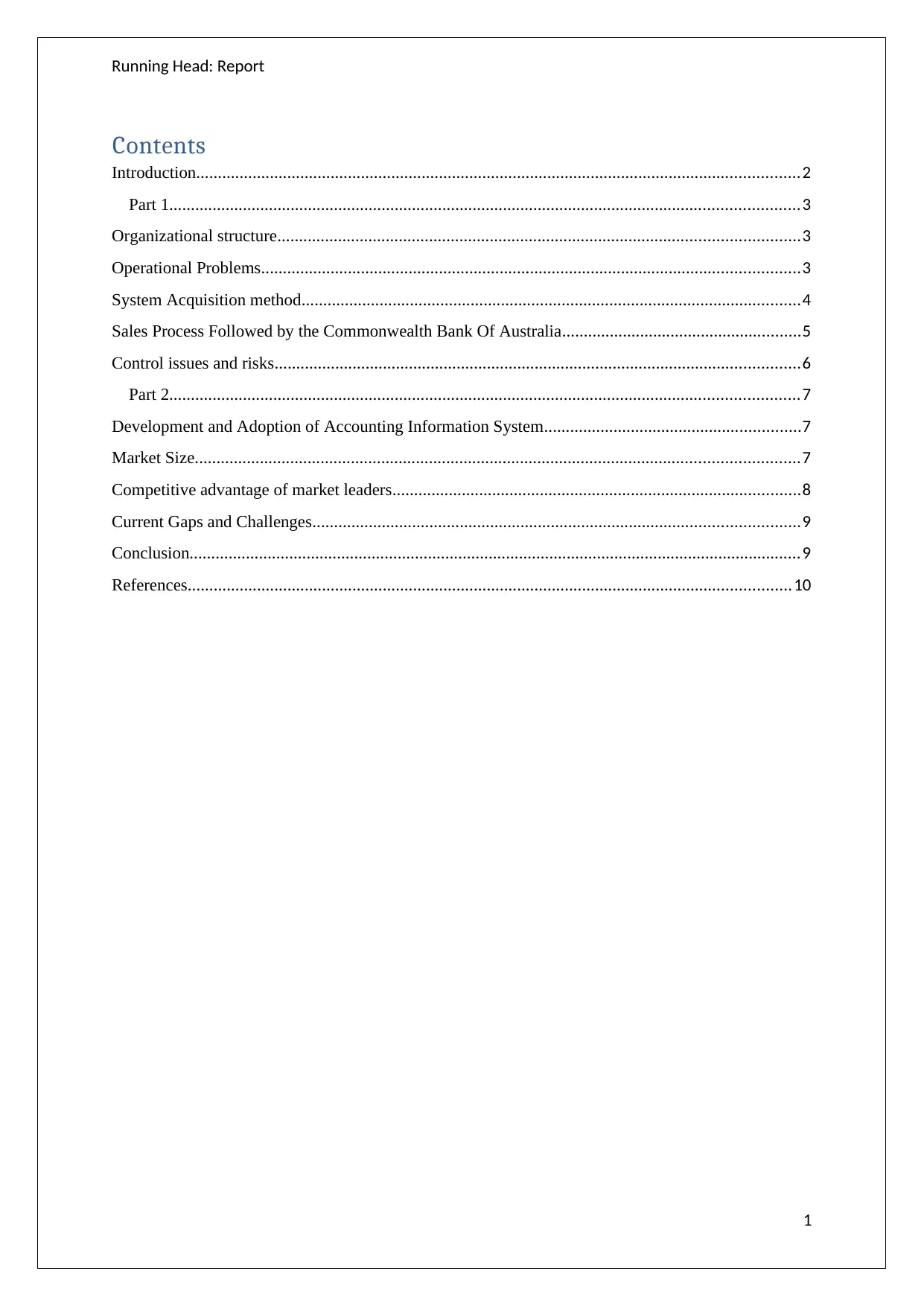
Running Head: Report
Contents
Introduction...........................................................................................................................................2
Part 1.................................................................................................................................................3
Organizational structure........................................................................................................................3
Operational Problems............................................................................................................................3
System Acquisition method...................................................................................................................4
Sales Process Followed by the Commonwealth Bank Of Australia.......................................................5
Control issues and risks.........................................................................................................................6
Part 2.................................................................................................................................................7
Development and Adoption of Accounting Information System...........................................................7
Market Size...........................................................................................................................................7
Competitive advantage of market leaders..............................................................................................8
Current Gaps and Challenges................................................................................................................9
Conclusion.............................................................................................................................................9
References...........................................................................................................................................10
1
Contents
Introduction...........................................................................................................................................2
Part 1.................................................................................................................................................3
Organizational structure........................................................................................................................3
Operational Problems............................................................................................................................3
System Acquisition method...................................................................................................................4
Sales Process Followed by the Commonwealth Bank Of Australia.......................................................5
Control issues and risks.........................................................................................................................6
Part 2.................................................................................................................................................7
Development and Adoption of Accounting Information System...........................................................7
Market Size...........................................................................................................................................7
Competitive advantage of market leaders..............................................................................................8
Current Gaps and Challenges................................................................................................................9
Conclusion.............................................................................................................................................9
References...........................................................................................................................................10
1
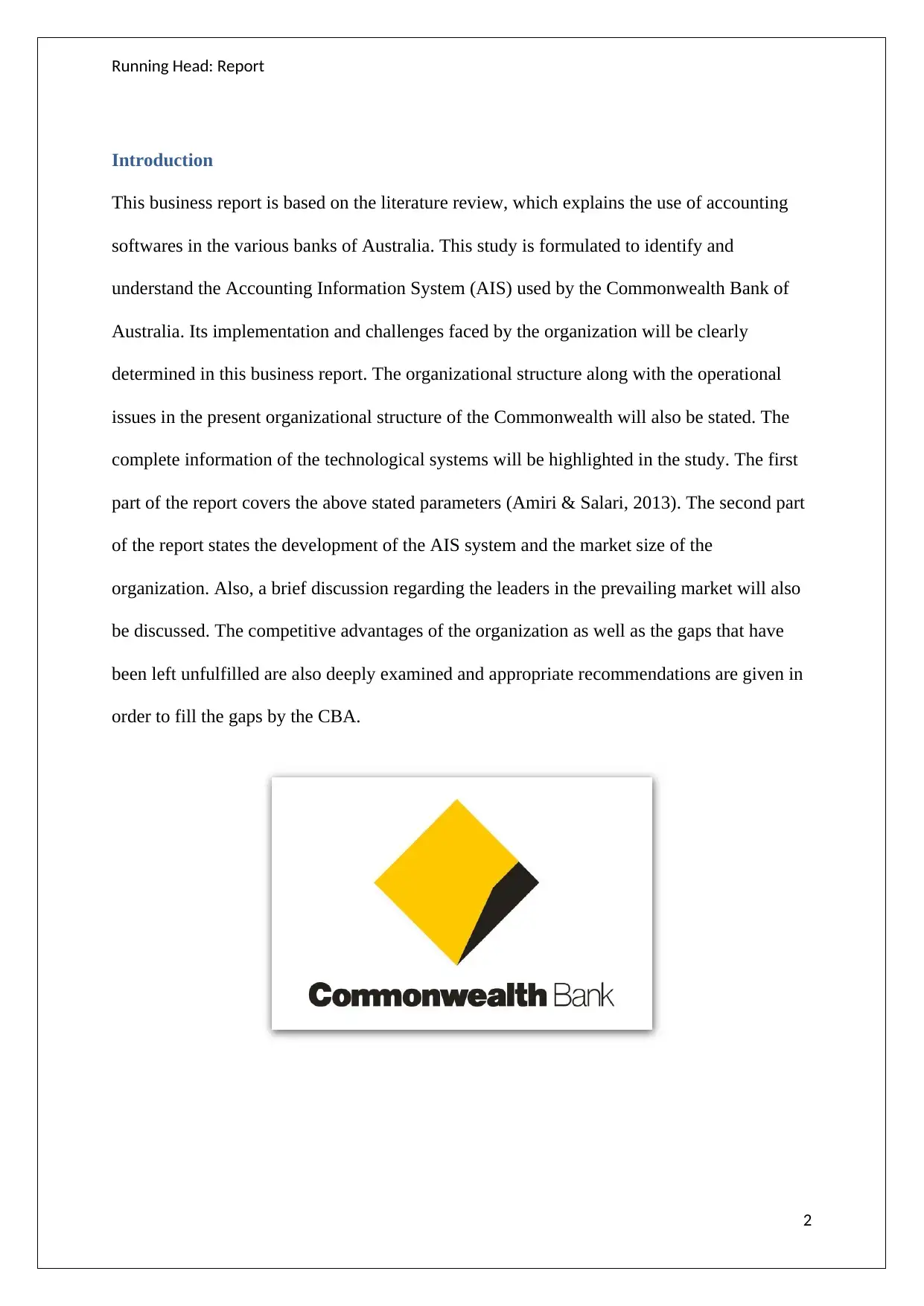
Running Head: Report
Introduction
This business report is based on the literature review, which explains the use of accounting
softwares in the various banks of Australia. This study is formulated to identify and
understand the Accounting Information System (AIS) used by the Commonwealth Bank of
Australia. Its implementation and challenges faced by the organization will be clearly
determined in this business report. The organizational structure along with the operational
issues in the present organizational structure of the Commonwealth will also be stated. The
complete information of the technological systems will be highlighted in the study. The first
part of the report covers the above stated parameters (Amiri & Salari, 2013). The second part
of the report states the development of the AIS system and the market size of the
organization. Also, a brief discussion regarding the leaders in the prevailing market will also
be discussed. The competitive advantages of the organization as well as the gaps that have
been left unfulfilled are also deeply examined and appropriate recommendations are given in
order to fill the gaps by the CBA.
2
Introduction
This business report is based on the literature review, which explains the use of accounting
softwares in the various banks of Australia. This study is formulated to identify and
understand the Accounting Information System (AIS) used by the Commonwealth Bank of
Australia. Its implementation and challenges faced by the organization will be clearly
determined in this business report. The organizational structure along with the operational
issues in the present organizational structure of the Commonwealth will also be stated. The
complete information of the technological systems will be highlighted in the study. The first
part of the report covers the above stated parameters (Amiri & Salari, 2013). The second part
of the report states the development of the AIS system and the market size of the
organization. Also, a brief discussion regarding the leaders in the prevailing market will also
be discussed. The competitive advantages of the organization as well as the gaps that have
been left unfulfilled are also deeply examined and appropriate recommendations are given in
order to fill the gaps by the CBA.
2
⊘ This is a preview!⊘
Do you want full access?
Subscribe today to unlock all pages.

Trusted by 1+ million students worldwide
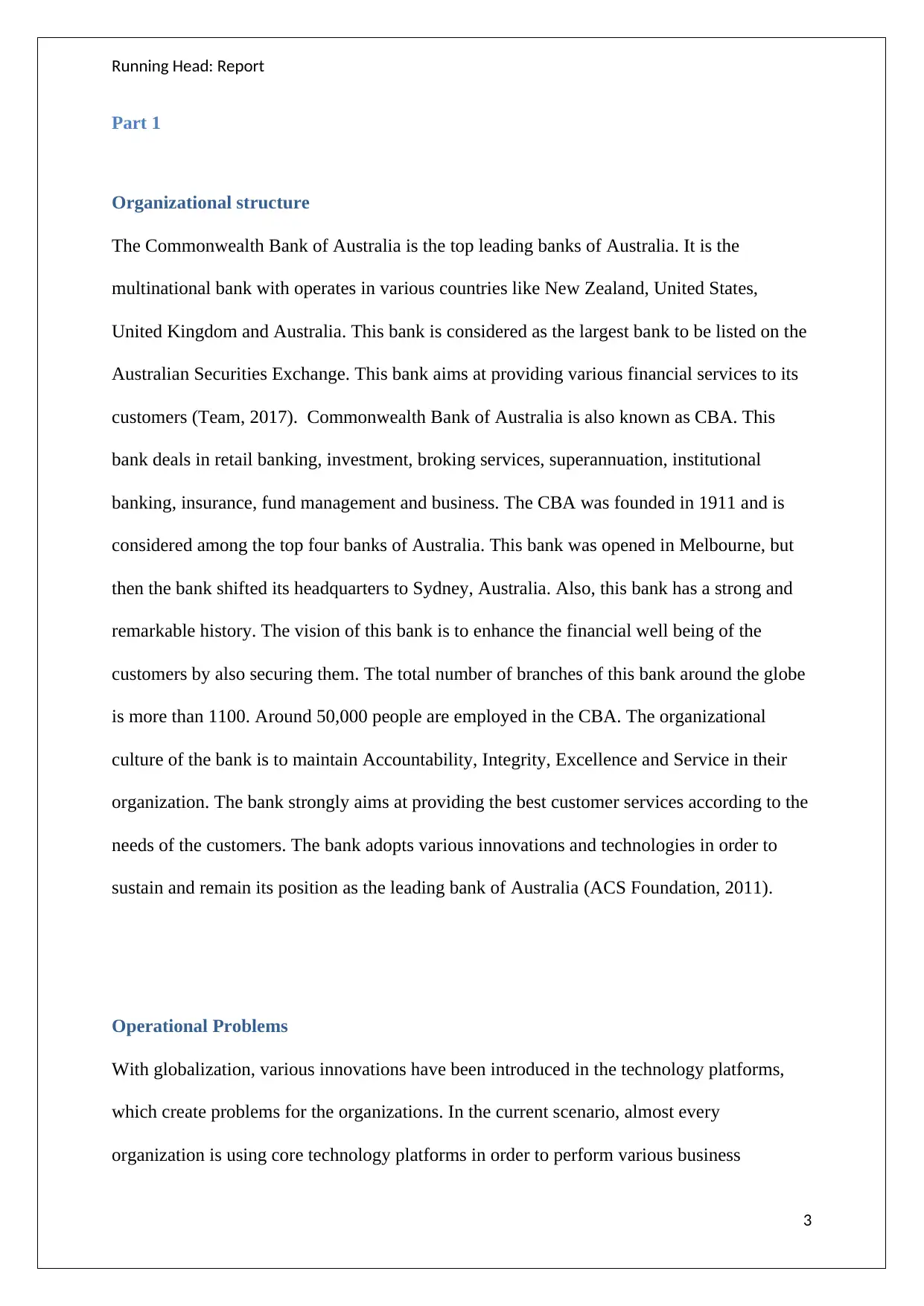
Running Head: Report
Part 1
Organizational structure
The Commonwealth Bank of Australia is the top leading banks of Australia. It is the
multinational bank with operates in various countries like New Zealand, United States,
United Kingdom and Australia. This bank is considered as the largest bank to be listed on the
Australian Securities Exchange. This bank aims at providing various financial services to its
customers (Team, 2017). Commonwealth Bank of Australia is also known as CBA. This
bank deals in retail banking, investment, broking services, superannuation, institutional
banking, insurance, fund management and business. The CBA was founded in 1911 and is
considered among the top four banks of Australia. This bank was opened in Melbourne, but
then the bank shifted its headquarters to Sydney, Australia. Also, this bank has a strong and
remarkable history. The vision of this bank is to enhance the financial well being of the
customers by also securing them. The total number of branches of this bank around the globe
is more than 1100. Around 50,000 people are employed in the CBA. The organizational
culture of the bank is to maintain Accountability, Integrity, Excellence and Service in their
organization. The bank strongly aims at providing the best customer services according to the
needs of the customers. The bank adopts various innovations and technologies in order to
sustain and remain its position as the leading bank of Australia (ACS Foundation, 2011).
Operational Problems
With globalization, various innovations have been introduced in the technology platforms,
which create problems for the organizations. In the current scenario, almost every
organization is using core technology platforms in order to perform various business
3
Part 1
Organizational structure
The Commonwealth Bank of Australia is the top leading banks of Australia. It is the
multinational bank with operates in various countries like New Zealand, United States,
United Kingdom and Australia. This bank is considered as the largest bank to be listed on the
Australian Securities Exchange. This bank aims at providing various financial services to its
customers (Team, 2017). Commonwealth Bank of Australia is also known as CBA. This
bank deals in retail banking, investment, broking services, superannuation, institutional
banking, insurance, fund management and business. The CBA was founded in 1911 and is
considered among the top four banks of Australia. This bank was opened in Melbourne, but
then the bank shifted its headquarters to Sydney, Australia. Also, this bank has a strong and
remarkable history. The vision of this bank is to enhance the financial well being of the
customers by also securing them. The total number of branches of this bank around the globe
is more than 1100. Around 50,000 people are employed in the CBA. The organizational
culture of the bank is to maintain Accountability, Integrity, Excellence and Service in their
organization. The bank strongly aims at providing the best customer services according to the
needs of the customers. The bank adopts various innovations and technologies in order to
sustain and remain its position as the leading bank of Australia (ACS Foundation, 2011).
Operational Problems
With globalization, various innovations have been introduced in the technology platforms,
which create problems for the organizations. In the current scenario, almost every
organization is using core technology platforms in order to perform various business
3
Paraphrase This Document
Need a fresh take? Get an instant paraphrase of this document with our AI Paraphraser
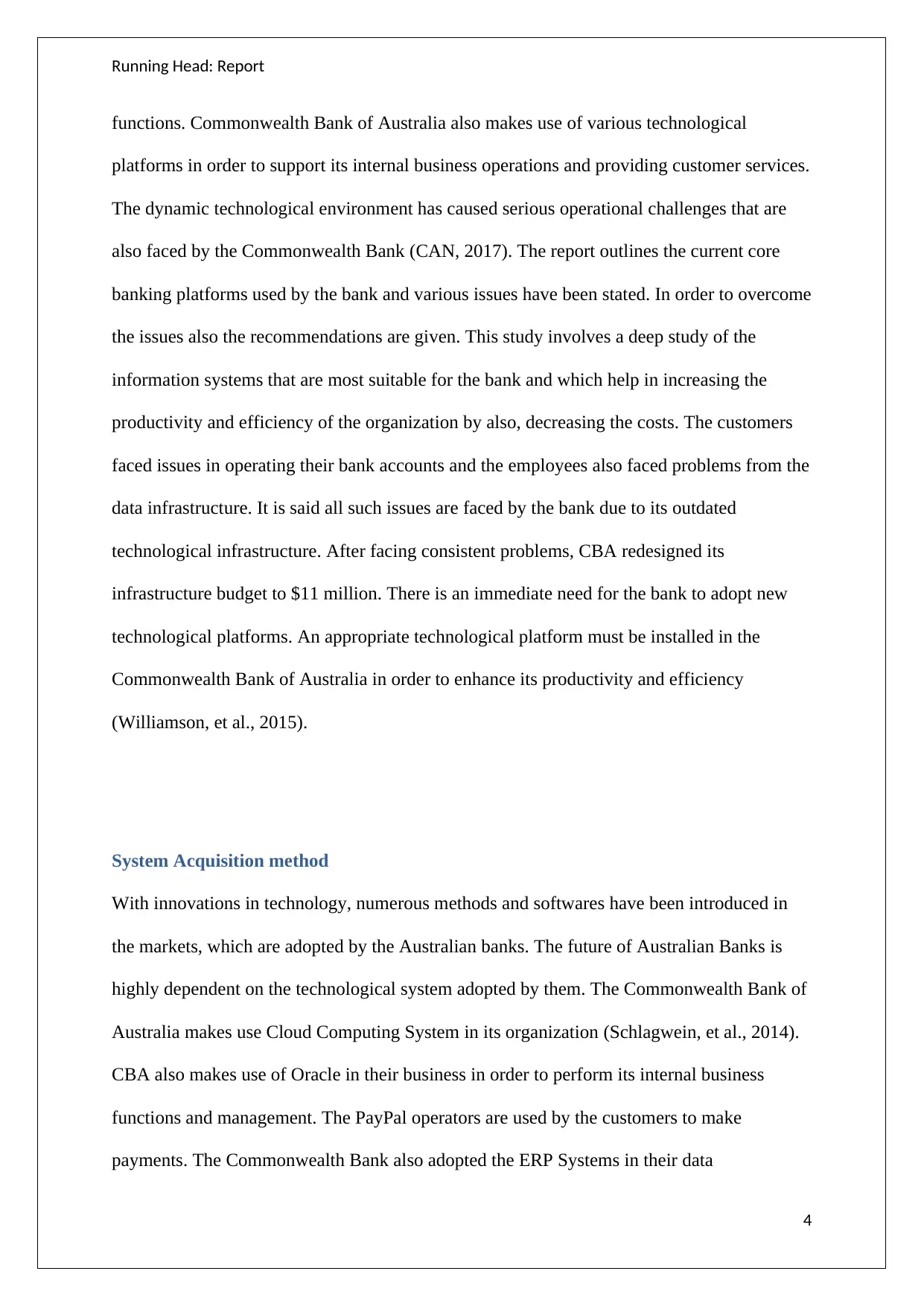
Running Head: Report
functions. Commonwealth Bank of Australia also makes use of various technological
platforms in order to support its internal business operations and providing customer services.
The dynamic technological environment has caused serious operational challenges that are
also faced by the Commonwealth Bank (CAN, 2017). The report outlines the current core
banking platforms used by the bank and various issues have been stated. In order to overcome
the issues also the recommendations are given. This study involves a deep study of the
information systems that are most suitable for the bank and which help in increasing the
productivity and efficiency of the organization by also, decreasing the costs. The customers
faced issues in operating their bank accounts and the employees also faced problems from the
data infrastructure. It is said all such issues are faced by the bank due to its outdated
technological infrastructure. After facing consistent problems, CBA redesigned its
infrastructure budget to $11 million. There is an immediate need for the bank to adopt new
technological platforms. An appropriate technological platform must be installed in the
Commonwealth Bank of Australia in order to enhance its productivity and efficiency
(Williamson, et al., 2015).
System Acquisition method
With innovations in technology, numerous methods and softwares have been introduced in
the markets, which are adopted by the Australian banks. The future of Australian Banks is
highly dependent on the technological system adopted by them. The Commonwealth Bank of
Australia makes use Cloud Computing System in its organization (Schlagwein, et al., 2014).
CBA also makes use of Oracle in their business in order to perform its internal business
functions and management. The PayPal operators are used by the customers to make
payments. The Commonwealth Bank also adopted the ERP Systems in their data
4
functions. Commonwealth Bank of Australia also makes use of various technological
platforms in order to support its internal business operations and providing customer services.
The dynamic technological environment has caused serious operational challenges that are
also faced by the Commonwealth Bank (CAN, 2017). The report outlines the current core
banking platforms used by the bank and various issues have been stated. In order to overcome
the issues also the recommendations are given. This study involves a deep study of the
information systems that are most suitable for the bank and which help in increasing the
productivity and efficiency of the organization by also, decreasing the costs. The customers
faced issues in operating their bank accounts and the employees also faced problems from the
data infrastructure. It is said all such issues are faced by the bank due to its outdated
technological infrastructure. After facing consistent problems, CBA redesigned its
infrastructure budget to $11 million. There is an immediate need for the bank to adopt new
technological platforms. An appropriate technological platform must be installed in the
Commonwealth Bank of Australia in order to enhance its productivity and efficiency
(Williamson, et al., 2015).
System Acquisition method
With innovations in technology, numerous methods and softwares have been introduced in
the markets, which are adopted by the Australian banks. The future of Australian Banks is
highly dependent on the technological system adopted by them. The Commonwealth Bank of
Australia makes use Cloud Computing System in its organization (Schlagwein, et al., 2014).
CBA also makes use of Oracle in their business in order to perform its internal business
functions and management. The PayPal operators are used by the customers to make
payments. The Commonwealth Bank also adopted the ERP Systems in their data
4
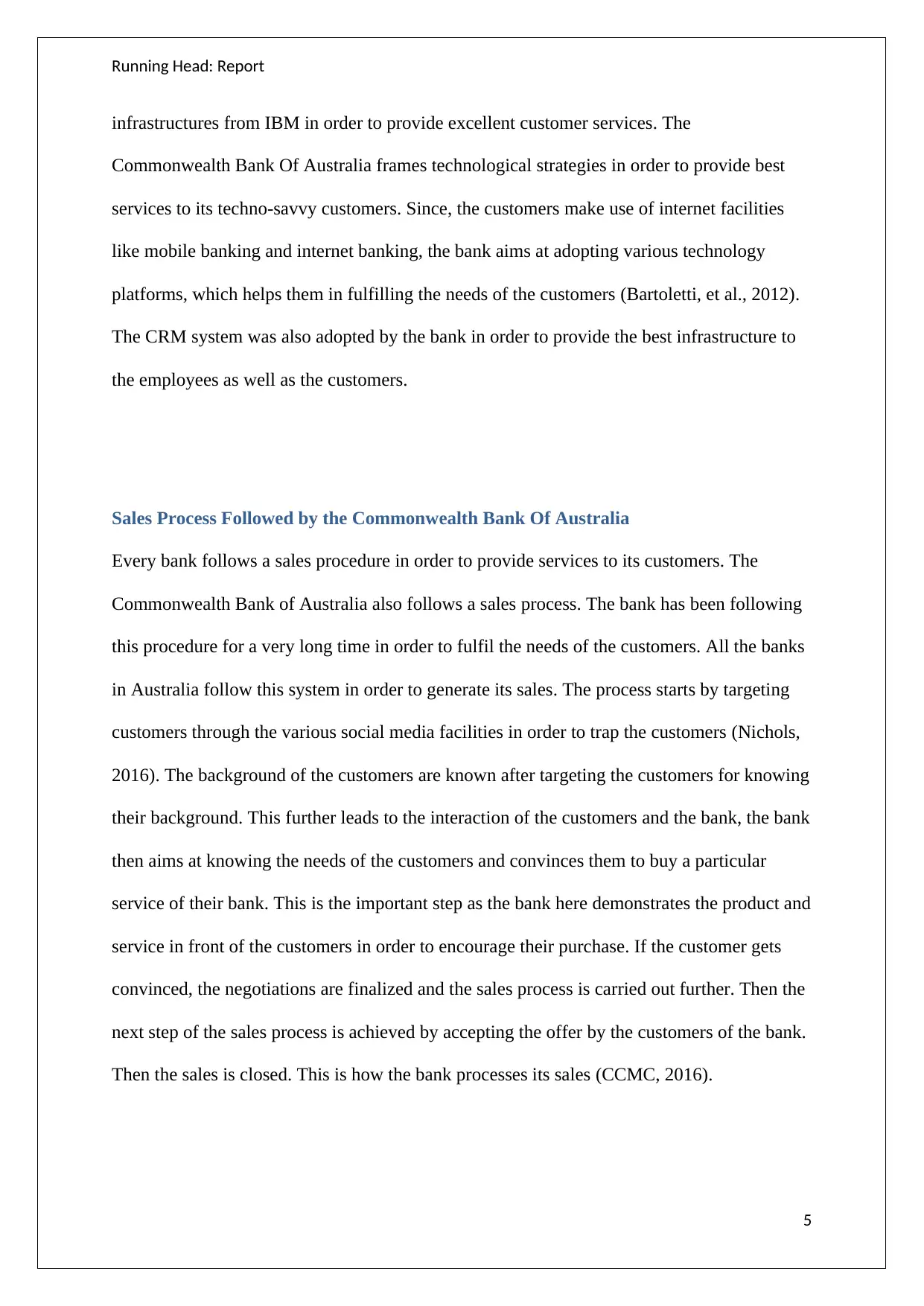
Running Head: Report
infrastructures from IBM in order to provide excellent customer services. The
Commonwealth Bank Of Australia frames technological strategies in order to provide best
services to its techno-savvy customers. Since, the customers make use of internet facilities
like mobile banking and internet banking, the bank aims at adopting various technology
platforms, which helps them in fulfilling the needs of the customers (Bartoletti, et al., 2012).
The CRM system was also adopted by the bank in order to provide the best infrastructure to
the employees as well as the customers.
Sales Process Followed by the Commonwealth Bank Of Australia
Every bank follows a sales procedure in order to provide services to its customers. The
Commonwealth Bank of Australia also follows a sales process. The bank has been following
this procedure for a very long time in order to fulfil the needs of the customers. All the banks
in Australia follow this system in order to generate its sales. The process starts by targeting
customers through the various social media facilities in order to trap the customers (Nichols,
2016). The background of the customers are known after targeting the customers for knowing
their background. This further leads to the interaction of the customers and the bank, the bank
then aims at knowing the needs of the customers and convinces them to buy a particular
service of their bank. This is the important step as the bank here demonstrates the product and
service in front of the customers in order to encourage their purchase. If the customer gets
convinced, the negotiations are finalized and the sales process is carried out further. Then the
next step of the sales process is achieved by accepting the offer by the customers of the bank.
Then the sales is closed. This is how the bank processes its sales (CCMC, 2016).
5
infrastructures from IBM in order to provide excellent customer services. The
Commonwealth Bank Of Australia frames technological strategies in order to provide best
services to its techno-savvy customers. Since, the customers make use of internet facilities
like mobile banking and internet banking, the bank aims at adopting various technology
platforms, which helps them in fulfilling the needs of the customers (Bartoletti, et al., 2012).
The CRM system was also adopted by the bank in order to provide the best infrastructure to
the employees as well as the customers.
Sales Process Followed by the Commonwealth Bank Of Australia
Every bank follows a sales procedure in order to provide services to its customers. The
Commonwealth Bank of Australia also follows a sales process. The bank has been following
this procedure for a very long time in order to fulfil the needs of the customers. All the banks
in Australia follow this system in order to generate its sales. The process starts by targeting
customers through the various social media facilities in order to trap the customers (Nichols,
2016). The background of the customers are known after targeting the customers for knowing
their background. This further leads to the interaction of the customers and the bank, the bank
then aims at knowing the needs of the customers and convinces them to buy a particular
service of their bank. This is the important step as the bank here demonstrates the product and
service in front of the customers in order to encourage their purchase. If the customer gets
convinced, the negotiations are finalized and the sales process is carried out further. Then the
next step of the sales process is achieved by accepting the offer by the customers of the bank.
Then the sales is closed. This is how the bank processes its sales (CCMC, 2016).
5
⊘ This is a preview!⊘
Do you want full access?
Subscribe today to unlock all pages.

Trusted by 1+ million students worldwide
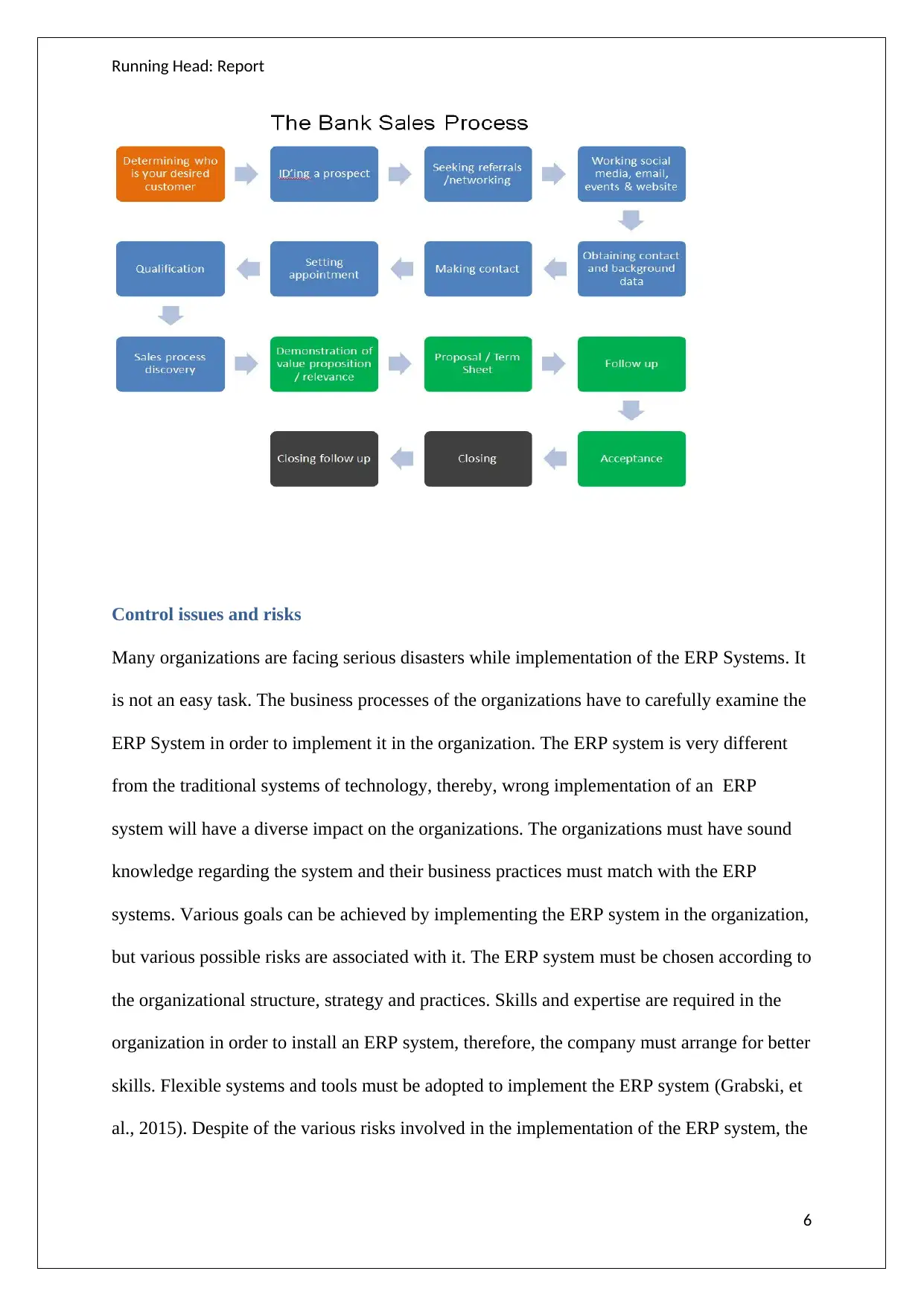
Running Head: Report
Control issues and risks
Many organizations are facing serious disasters while implementation of the ERP Systems. It
is not an easy task. The business processes of the organizations have to carefully examine the
ERP System in order to implement it in the organization. The ERP system is very different
from the traditional systems of technology, thereby, wrong implementation of an ERP
system will have a diverse impact on the organizations. The organizations must have sound
knowledge regarding the system and their business practices must match with the ERP
systems. Various goals can be achieved by implementing the ERP system in the organization,
but various possible risks are associated with it. The ERP system must be chosen according to
the organizational structure, strategy and practices. Skills and expertise are required in the
organization in order to install an ERP system, therefore, the company must arrange for better
skills. Flexible systems and tools must be adopted to implement the ERP system (Grabski, et
al., 2015). Despite of the various risks involved in the implementation of the ERP system, the
6
Control issues and risks
Many organizations are facing serious disasters while implementation of the ERP Systems. It
is not an easy task. The business processes of the organizations have to carefully examine the
ERP System in order to implement it in the organization. The ERP system is very different
from the traditional systems of technology, thereby, wrong implementation of an ERP
system will have a diverse impact on the organizations. The organizations must have sound
knowledge regarding the system and their business practices must match with the ERP
systems. Various goals can be achieved by implementing the ERP system in the organization,
but various possible risks are associated with it. The ERP system must be chosen according to
the organizational structure, strategy and practices. Skills and expertise are required in the
organization in order to install an ERP system, therefore, the company must arrange for better
skills. Flexible systems and tools must be adopted to implement the ERP system (Grabski, et
al., 2015). Despite of the various risks involved in the implementation of the ERP system, the
6
Paraphrase This Document
Need a fresh take? Get an instant paraphrase of this document with our AI Paraphraser
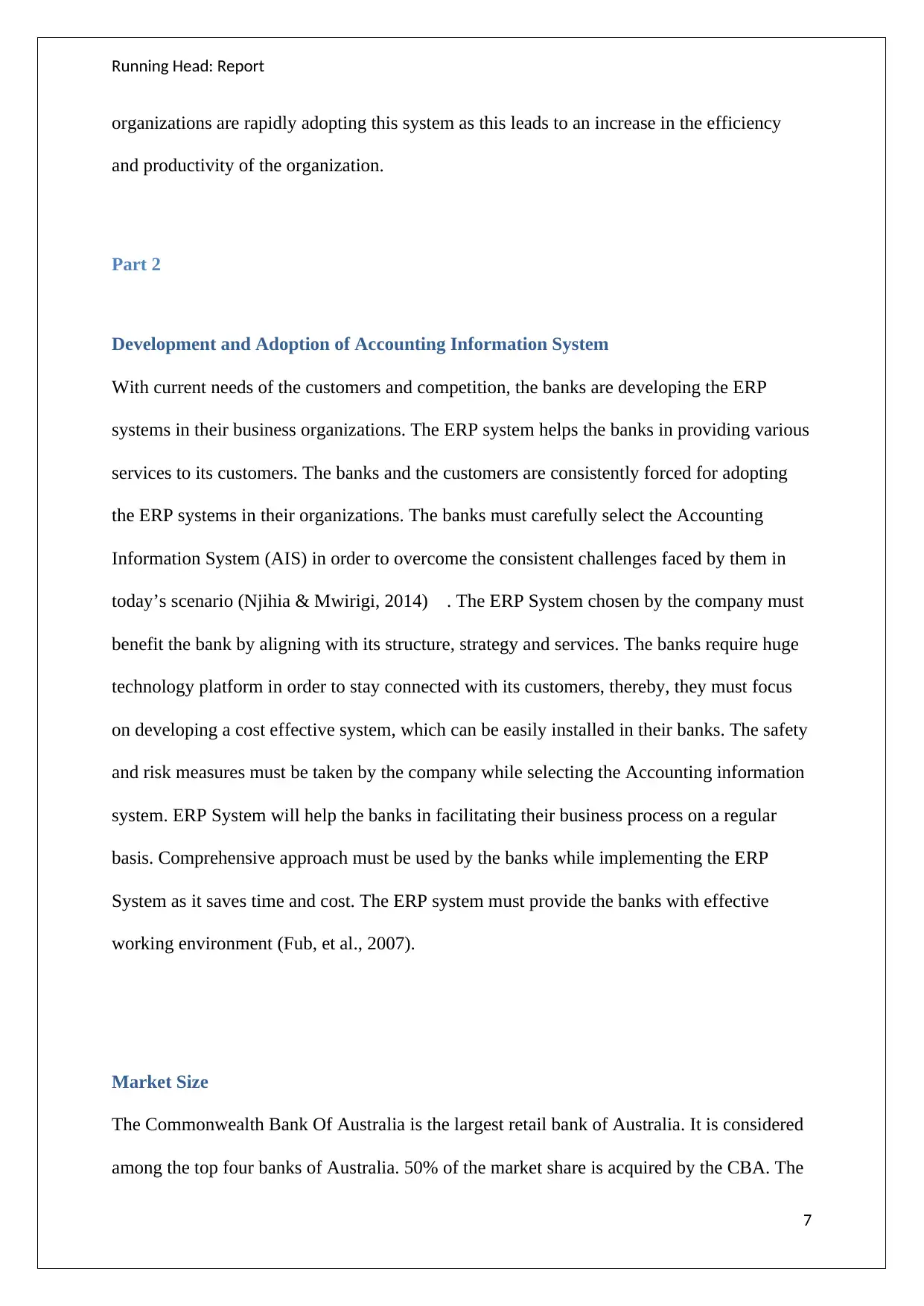
Running Head: Report
organizations are rapidly adopting this system as this leads to an increase in the efficiency
and productivity of the organization.
Part 2
Development and Adoption of Accounting Information System
With current needs of the customers and competition, the banks are developing the ERP
systems in their business organizations. The ERP system helps the banks in providing various
services to its customers. The banks and the customers are consistently forced for adopting
the ERP systems in their organizations. The banks must carefully select the Accounting
Information System (AIS) in order to overcome the consistent challenges faced by them in
today’s scenario (Njihia & Mwirigi, 2014) . The ERP System chosen by the company must
benefit the bank by aligning with its structure, strategy and services. The banks require huge
technology platform in order to stay connected with its customers, thereby, they must focus
on developing a cost effective system, which can be easily installed in their banks. The safety
and risk measures must be taken by the company while selecting the Accounting information
system. ERP System will help the banks in facilitating their business process on a regular
basis. Comprehensive approach must be used by the banks while implementing the ERP
System as it saves time and cost. The ERP system must provide the banks with effective
working environment (Fub, et al., 2007).
Market Size
The Commonwealth Bank Of Australia is the largest retail bank of Australia. It is considered
among the top four banks of Australia. 50% of the market share is acquired by the CBA. The
7
organizations are rapidly adopting this system as this leads to an increase in the efficiency
and productivity of the organization.
Part 2
Development and Adoption of Accounting Information System
With current needs of the customers and competition, the banks are developing the ERP
systems in their business organizations. The ERP system helps the banks in providing various
services to its customers. The banks and the customers are consistently forced for adopting
the ERP systems in their organizations. The banks must carefully select the Accounting
Information System (AIS) in order to overcome the consistent challenges faced by them in
today’s scenario (Njihia & Mwirigi, 2014) . The ERP System chosen by the company must
benefit the bank by aligning with its structure, strategy and services. The banks require huge
technology platform in order to stay connected with its customers, thereby, they must focus
on developing a cost effective system, which can be easily installed in their banks. The safety
and risk measures must be taken by the company while selecting the Accounting information
system. ERP System will help the banks in facilitating their business process on a regular
basis. Comprehensive approach must be used by the banks while implementing the ERP
System as it saves time and cost. The ERP system must provide the banks with effective
working environment (Fub, et al., 2007).
Market Size
The Commonwealth Bank Of Australia is the largest retail bank of Australia. It is considered
among the top four banks of Australia. 50% of the market share is acquired by the CBA. The
7
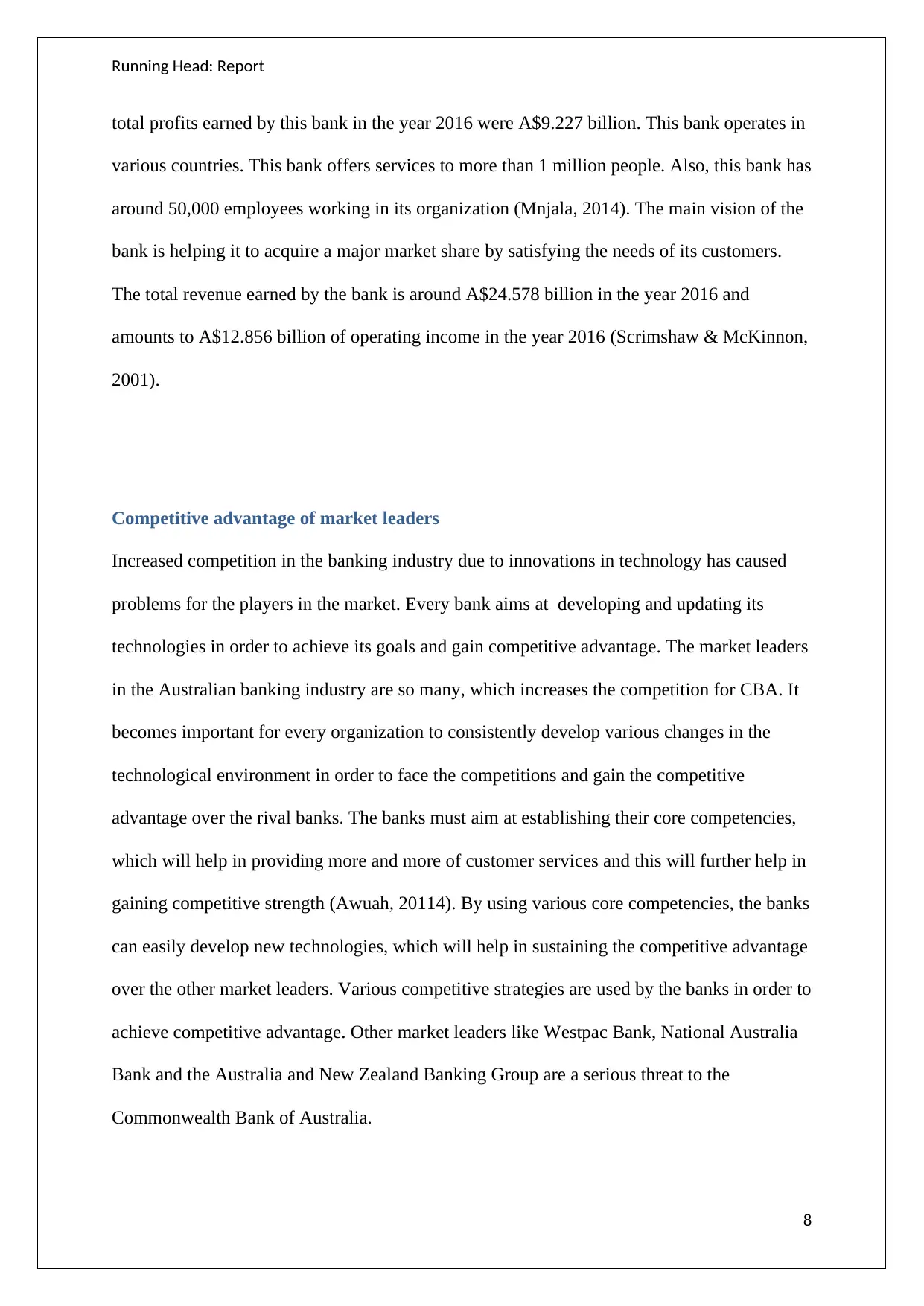
Running Head: Report
total profits earned by this bank in the year 2016 were A$9.227 billion. This bank operates in
various countries. This bank offers services to more than 1 million people. Also, this bank has
around 50,000 employees working in its organization (Mnjala, 2014). The main vision of the
bank is helping it to acquire a major market share by satisfying the needs of its customers.
The total revenue earned by the bank is around A$24.578 billion in the year 2016 and
amounts to A$12.856 billion of operating income in the year 2016 (Scrimshaw & McKinnon,
2001).
Competitive advantage of market leaders
Increased competition in the banking industry due to innovations in technology has caused
problems for the players in the market. Every bank aims at developing and updating its
technologies in order to achieve its goals and gain competitive advantage. The market leaders
in the Australian banking industry are so many, which increases the competition for CBA. It
becomes important for every organization to consistently develop various changes in the
technological environment in order to face the competitions and gain the competitive
advantage over the rival banks. The banks must aim at establishing their core competencies,
which will help in providing more and more of customer services and this will further help in
gaining competitive strength (Awuah, 20114). By using various core competencies, the banks
can easily develop new technologies, which will help in sustaining the competitive advantage
over the other market leaders. Various competitive strategies are used by the banks in order to
achieve competitive advantage. Other market leaders like Westpac Bank, National Australia
Bank and the Australia and New Zealand Banking Group are a serious threat to the
Commonwealth Bank of Australia.
8
total profits earned by this bank in the year 2016 were A$9.227 billion. This bank operates in
various countries. This bank offers services to more than 1 million people. Also, this bank has
around 50,000 employees working in its organization (Mnjala, 2014). The main vision of the
bank is helping it to acquire a major market share by satisfying the needs of its customers.
The total revenue earned by the bank is around A$24.578 billion in the year 2016 and
amounts to A$12.856 billion of operating income in the year 2016 (Scrimshaw & McKinnon,
2001).
Competitive advantage of market leaders
Increased competition in the banking industry due to innovations in technology has caused
problems for the players in the market. Every bank aims at developing and updating its
technologies in order to achieve its goals and gain competitive advantage. The market leaders
in the Australian banking industry are so many, which increases the competition for CBA. It
becomes important for every organization to consistently develop various changes in the
technological environment in order to face the competitions and gain the competitive
advantage over the rival banks. The banks must aim at establishing their core competencies,
which will help in providing more and more of customer services and this will further help in
gaining competitive strength (Awuah, 20114). By using various core competencies, the banks
can easily develop new technologies, which will help in sustaining the competitive advantage
over the other market leaders. Various competitive strategies are used by the banks in order to
achieve competitive advantage. Other market leaders like Westpac Bank, National Australia
Bank and the Australia and New Zealand Banking Group are a serious threat to the
Commonwealth Bank of Australia.
8
⊘ This is a preview!⊘
Do you want full access?
Subscribe today to unlock all pages.

Trusted by 1+ million students worldwide
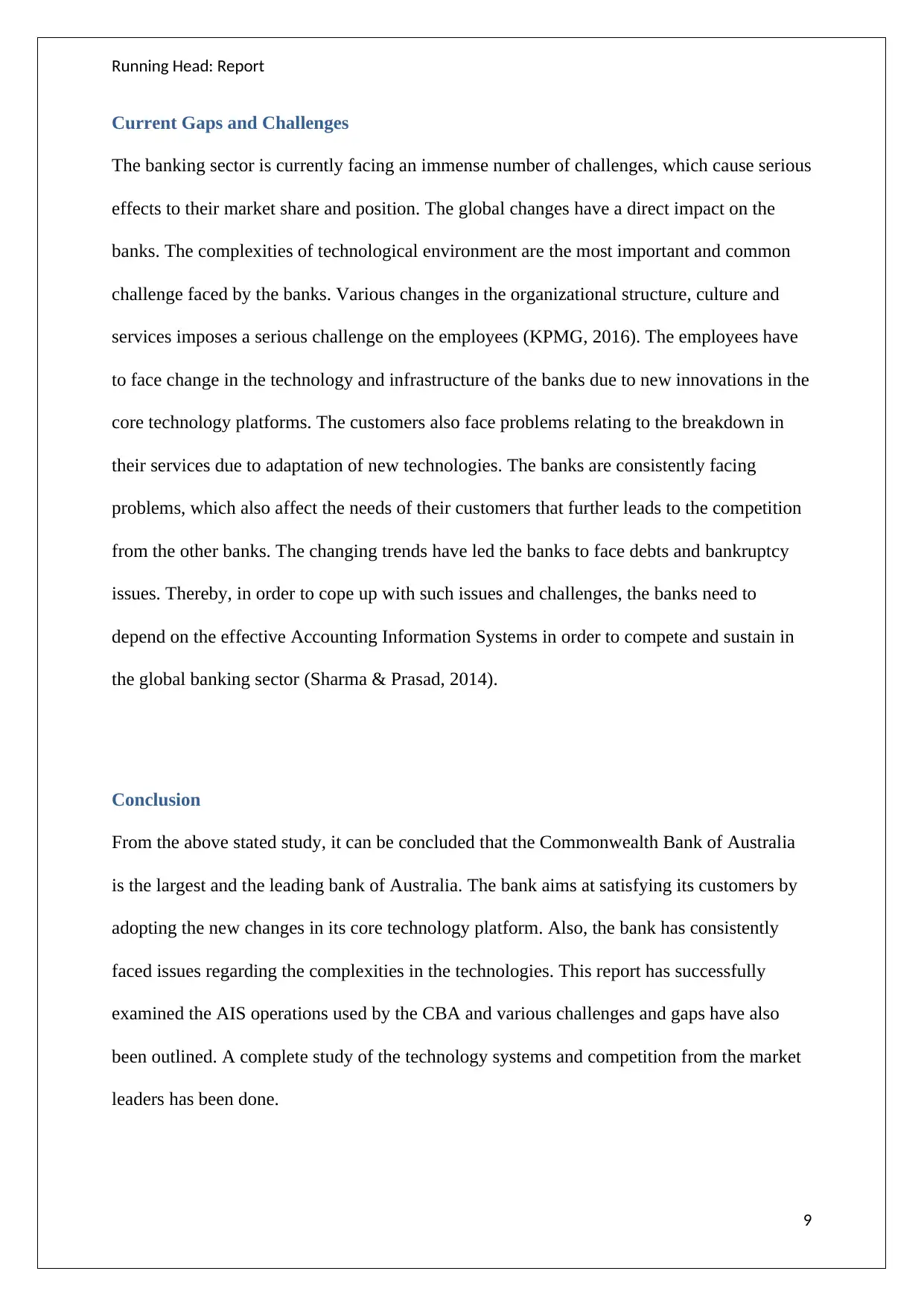
Running Head: Report
Current Gaps and Challenges
The banking sector is currently facing an immense number of challenges, which cause serious
effects to their market share and position. The global changes have a direct impact on the
banks. The complexities of technological environment are the most important and common
challenge faced by the banks. Various changes in the organizational structure, culture and
services imposes a serious challenge on the employees (KPMG, 2016). The employees have
to face change in the technology and infrastructure of the banks due to new innovations in the
core technology platforms. The customers also face problems relating to the breakdown in
their services due to adaptation of new technologies. The banks are consistently facing
problems, which also affect the needs of their customers that further leads to the competition
from the other banks. The changing trends have led the banks to face debts and bankruptcy
issues. Thereby, in order to cope up with such issues and challenges, the banks need to
depend on the effective Accounting Information Systems in order to compete and sustain in
the global banking sector (Sharma & Prasad, 2014).
Conclusion
From the above stated study, it can be concluded that the Commonwealth Bank of Australia
is the largest and the leading bank of Australia. The bank aims at satisfying its customers by
adopting the new changes in its core technology platform. Also, the bank has consistently
faced issues regarding the complexities in the technologies. This report has successfully
examined the AIS operations used by the CBA and various challenges and gaps have also
been outlined. A complete study of the technology systems and competition from the market
leaders has been done.
9
Current Gaps and Challenges
The banking sector is currently facing an immense number of challenges, which cause serious
effects to their market share and position. The global changes have a direct impact on the
banks. The complexities of technological environment are the most important and common
challenge faced by the banks. Various changes in the organizational structure, culture and
services imposes a serious challenge on the employees (KPMG, 2016). The employees have
to face change in the technology and infrastructure of the banks due to new innovations in the
core technology platforms. The customers also face problems relating to the breakdown in
their services due to adaptation of new technologies. The banks are consistently facing
problems, which also affect the needs of their customers that further leads to the competition
from the other banks. The changing trends have led the banks to face debts and bankruptcy
issues. Thereby, in order to cope up with such issues and challenges, the banks need to
depend on the effective Accounting Information Systems in order to compete and sustain in
the global banking sector (Sharma & Prasad, 2014).
Conclusion
From the above stated study, it can be concluded that the Commonwealth Bank of Australia
is the largest and the leading bank of Australia. The bank aims at satisfying its customers by
adopting the new changes in its core technology platform. Also, the bank has consistently
faced issues regarding the complexities in the technologies. This report has successfully
examined the AIS operations used by the CBA and various challenges and gaps have also
been outlined. A complete study of the technology systems and competition from the market
leaders has been done.
9
Paraphrase This Document
Need a fresh take? Get an instant paraphrase of this document with our AI Paraphraser
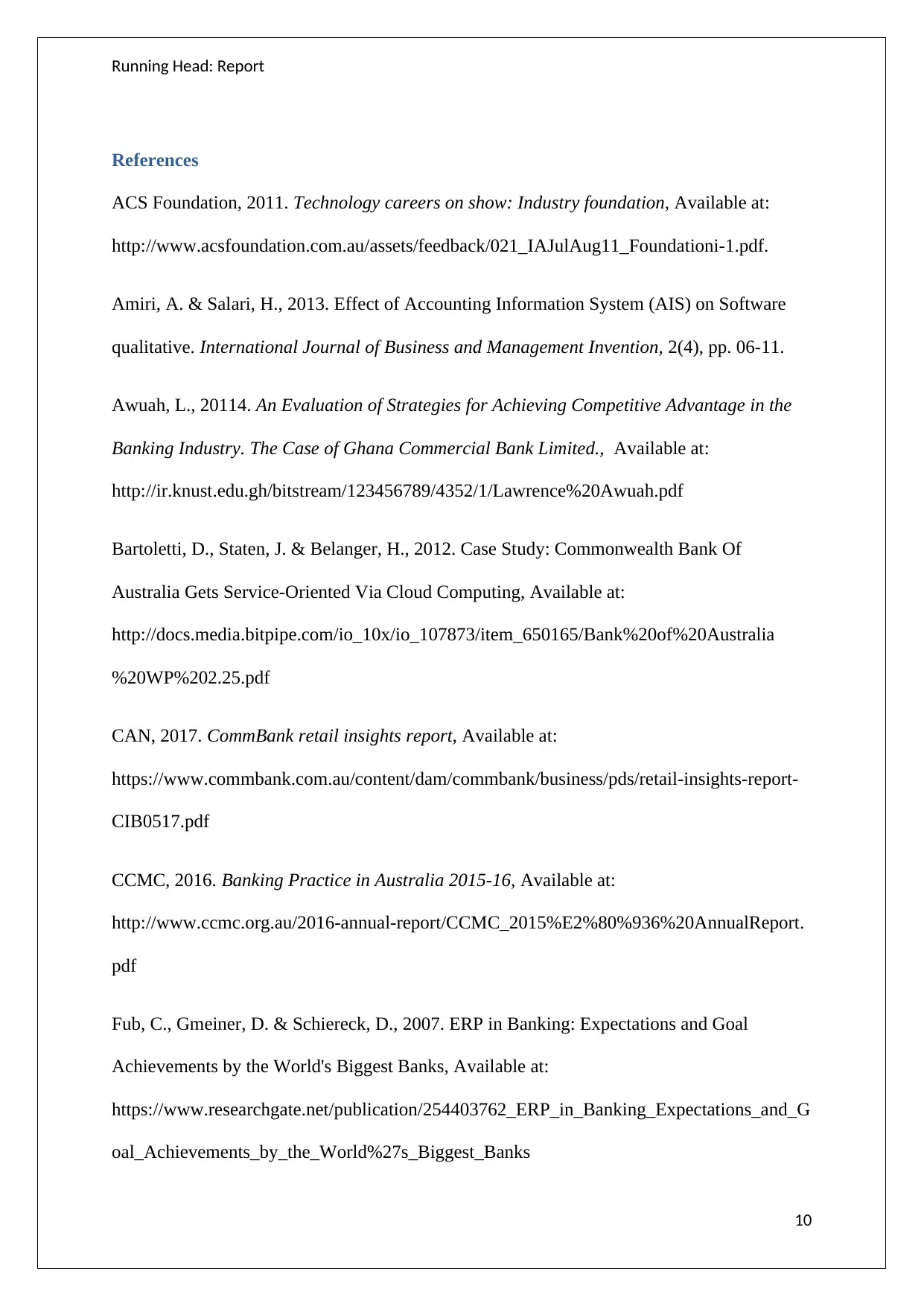
Running Head: Report
References
ACS Foundation, 2011. Technology careers on show: Industry foundation, Available at:
http://www.acsfoundation.com.au/assets/feedback/021_IAJulAug11_Foundationi-1.pdf.
Amiri, A. & Salari, H., 2013. Effect of Accounting Information System (AIS) on Software
qualitative. International Journal of Business and Management Invention, 2(4), pp. 06-11.
Awuah, L., 20114. An Evaluation of Strategies for Achieving Competitive Advantage in the
Banking Industry. The Case of Ghana Commercial Bank Limited., Available at:
http://ir.knust.edu.gh/bitstream/123456789/4352/1/Lawrence%20Awuah.pdf
Bartoletti, D., Staten, J. & Belanger, H., 2012. Case Study: Commonwealth Bank Of
Australia Gets Service-Oriented Via Cloud Computing, Available at:
http://docs.media.bitpipe.com/io_10x/io_107873/item_650165/Bank%20of%20Australia
%20WP%202.25.pdf
CAN, 2017. CommBank retail insights report, Available at:
https://www.commbank.com.au/content/dam/commbank/business/pds/retail-insights-report-
CIB0517.pdf
CCMC, 2016. Banking Practice in Australia 2015-16, Available at:
http://www.ccmc.org.au/2016-annual-report/CCMC_2015%E2%80%936%20AnnualReport.
pdf
Fub, C., Gmeiner, D. & Schiereck, D., 2007. ERP in Banking: Expectations and Goal
Achievements by the World's Biggest Banks, Available at:
https://www.researchgate.net/publication/254403762_ERP_in_Banking_Expectations_and_G
oal_Achievements_by_the_World%27s_Biggest_Banks
10
References
ACS Foundation, 2011. Technology careers on show: Industry foundation, Available at:
http://www.acsfoundation.com.au/assets/feedback/021_IAJulAug11_Foundationi-1.pdf.
Amiri, A. & Salari, H., 2013. Effect of Accounting Information System (AIS) on Software
qualitative. International Journal of Business and Management Invention, 2(4), pp. 06-11.
Awuah, L., 20114. An Evaluation of Strategies for Achieving Competitive Advantage in the
Banking Industry. The Case of Ghana Commercial Bank Limited., Available at:
http://ir.knust.edu.gh/bitstream/123456789/4352/1/Lawrence%20Awuah.pdf
Bartoletti, D., Staten, J. & Belanger, H., 2012. Case Study: Commonwealth Bank Of
Australia Gets Service-Oriented Via Cloud Computing, Available at:
http://docs.media.bitpipe.com/io_10x/io_107873/item_650165/Bank%20of%20Australia
%20WP%202.25.pdf
CAN, 2017. CommBank retail insights report, Available at:
https://www.commbank.com.au/content/dam/commbank/business/pds/retail-insights-report-
CIB0517.pdf
CCMC, 2016. Banking Practice in Australia 2015-16, Available at:
http://www.ccmc.org.au/2016-annual-report/CCMC_2015%E2%80%936%20AnnualReport.
Fub, C., Gmeiner, D. & Schiereck, D., 2007. ERP in Banking: Expectations and Goal
Achievements by the World's Biggest Banks, Available at:
https://www.researchgate.net/publication/254403762_ERP_in_Banking_Expectations_and_G
oal_Achievements_by_the_World%27s_Biggest_Banks
10
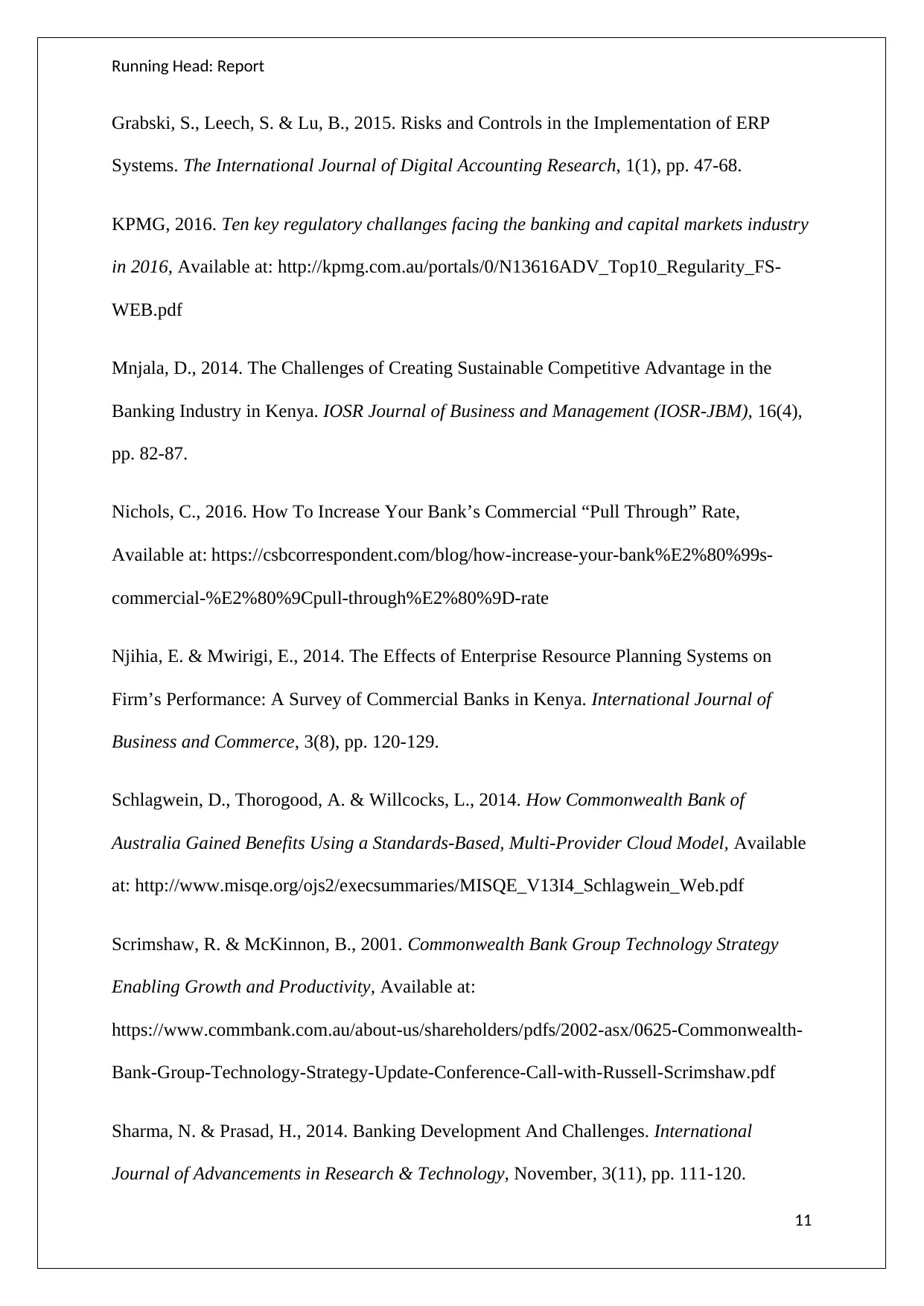
Running Head: Report
Grabski, S., Leech, S. & Lu, B., 2015. Risks and Controls in the Implementation of ERP
Systems. The International Journal of Digital Accounting Research, 1(1), pp. 47-68.
KPMG, 2016. Ten key regulatory challanges facing the banking and capital markets industry
in 2016, Available at: http://kpmg.com.au/portals/0/N13616ADV_Top10_Regularity_FS-
WEB.pdf
Mnjala, D., 2014. The Challenges of Creating Sustainable Competitive Advantage in the
Banking Industry in Kenya. IOSR Journal of Business and Management (IOSR-JBM), 16(4),
pp. 82-87.
Nichols, C., 2016. How To Increase Your Bank’s Commercial “Pull Through” Rate,
Available at: https://csbcorrespondent.com/blog/how-increase-your-bank%E2%80%99s-
commercial-%E2%80%9Cpull-through%E2%80%9D-rate
Njihia, E. & Mwirigi, E., 2014. The Effects of Enterprise Resource Planning Systems on
Firm’s Performance: A Survey of Commercial Banks in Kenya. International Journal of
Business and Commerce, 3(8), pp. 120-129.
Schlagwein, D., Thorogood, A. & Willcocks, L., 2014. How Commonwealth Bank of
Australia Gained Benefits Using a Standards-Based, Multi-Provider Cloud Model, Available
at: http://www.misqe.org/ojs2/execsummaries/MISQE_V13I4_Schlagwein_Web.pdf
Scrimshaw, R. & McKinnon, B., 2001. Commonwealth Bank Group Technology Strategy
Enabling Growth and Productivity, Available at:
https://www.commbank.com.au/about-us/shareholders/pdfs/2002-asx/0625-Commonwealth-
Bank-Group-Technology-Strategy-Update-Conference-Call-with-Russell-Scrimshaw.pdf
Sharma, N. & Prasad, H., 2014. Banking Development And Challenges. International
Journal of Advancements in Research & Technology, November, 3(11), pp. 111-120.
11
Grabski, S., Leech, S. & Lu, B., 2015. Risks and Controls in the Implementation of ERP
Systems. The International Journal of Digital Accounting Research, 1(1), pp. 47-68.
KPMG, 2016. Ten key regulatory challanges facing the banking and capital markets industry
in 2016, Available at: http://kpmg.com.au/portals/0/N13616ADV_Top10_Regularity_FS-
WEB.pdf
Mnjala, D., 2014. The Challenges of Creating Sustainable Competitive Advantage in the
Banking Industry in Kenya. IOSR Journal of Business and Management (IOSR-JBM), 16(4),
pp. 82-87.
Nichols, C., 2016. How To Increase Your Bank’s Commercial “Pull Through” Rate,
Available at: https://csbcorrespondent.com/blog/how-increase-your-bank%E2%80%99s-
commercial-%E2%80%9Cpull-through%E2%80%9D-rate
Njihia, E. & Mwirigi, E., 2014. The Effects of Enterprise Resource Planning Systems on
Firm’s Performance: A Survey of Commercial Banks in Kenya. International Journal of
Business and Commerce, 3(8), pp. 120-129.
Schlagwein, D., Thorogood, A. & Willcocks, L., 2014. How Commonwealth Bank of
Australia Gained Benefits Using a Standards-Based, Multi-Provider Cloud Model, Available
at: http://www.misqe.org/ojs2/execsummaries/MISQE_V13I4_Schlagwein_Web.pdf
Scrimshaw, R. & McKinnon, B., 2001. Commonwealth Bank Group Technology Strategy
Enabling Growth and Productivity, Available at:
https://www.commbank.com.au/about-us/shareholders/pdfs/2002-asx/0625-Commonwealth-
Bank-Group-Technology-Strategy-Update-Conference-Call-with-Russell-Scrimshaw.pdf
Sharma, N. & Prasad, H., 2014. Banking Development And Challenges. International
Journal of Advancements in Research & Technology, November, 3(11), pp. 111-120.
11
⊘ This is a preview!⊘
Do you want full access?
Subscribe today to unlock all pages.

Trusted by 1+ million students worldwide
1 out of 13
Related Documents
Your All-in-One AI-Powered Toolkit for Academic Success.
+13062052269
info@desklib.com
Available 24*7 on WhatsApp / Email
![[object Object]](/_next/static/media/star-bottom.7253800d.svg)
Unlock your academic potential
Copyright © 2020–2025 A2Z Services. All Rights Reserved. Developed and managed by ZUCOL.




